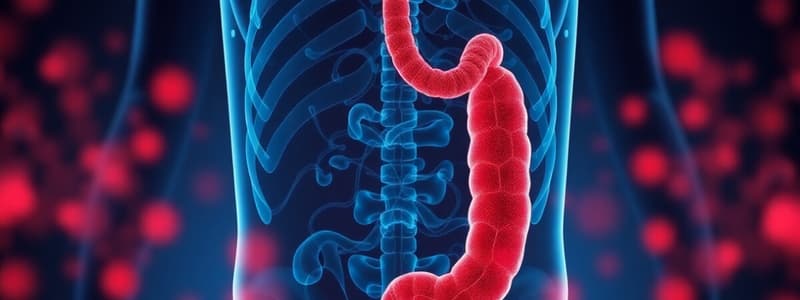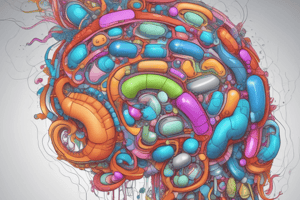Podcast
Questions and Answers
What is the primary mechanism of action of bisacodyl?
What is the primary mechanism of action of bisacodyl?
- Increases electrolyte and water secretion by the mucosa (correct)
- Decreases peristalsis through stimulation of enteric nerves
- Directly stimulates the myenteric plexus
- Increases gastric emptying rate
Which side effect is commonly associated with stimulant laxatives such as senna?
Which side effect is commonly associated with stimulant laxatives such as senna?
- Abdominal cramping (correct)
- Decreased appetite
- Constipation
- Gallbladder issues
In which scenario is the use of senna contraindicated?
In which scenario is the use of senna contraindicated?
- Patients with bowel obstruction (correct)
- Terminally ill patients
- Preparation for digestive assessments
- Bedridden patients
What is the mechanism of action for bulk laxatives?
What is the mechanism of action for bulk laxatives?
What pharmacological class does prucalopride belong to?
What pharmacological class does prucalopride belong to?
Which laxative type is contraindicated in patients with poor renal function?
Which laxative type is contraindicated in patients with poor renal function?
What is a significant use of metoclopramide?
What is a significant use of metoclopramide?
Which of the following is true about sodium picosulfate?
Which of the following is true about sodium picosulfate?
What is a common adverse effect associated with osmotic laxatives?
What is a common adverse effect associated with osmotic laxatives?
For which group of patients is the use of stimulant laxatives often indicated?
For which group of patients is the use of stimulant laxatives often indicated?
Which of the following describes the action of faecal softeners?
Which of the following describes the action of faecal softeners?
Which agent is considered the first choice for chronic constipation?
Which agent is considered the first choice for chronic constipation?
Which of the following agents is specifically used for constipated patients with irritable bowel syndrome?
Which of the following agents is specifically used for constipated patients with irritable bowel syndrome?
What is a known adverse reaction associated with bulk laxatives?
What is a known adverse reaction associated with bulk laxatives?
Which laxative is known for an effect within about one hour?
Which laxative is known for an effect within about one hour?
What is the action of prokinetic drugs in the GI tract?
What is the action of prokinetic drugs in the GI tract?
Which of the following statements about prokinetic drugs is true?
Which of the following statements about prokinetic drugs is true?
What is the mechanism of action of lubiprostone?
What is the mechanism of action of lubiprostone?
Naloxegol is primarily indicated for which condition?
Naloxegol is primarily indicated for which condition?
What are the primary side effects associated with loperamide?
What are the primary side effects associated with loperamide?
What is the main consequence of gastrointestinal motility increase during diarrhea?
What is the main consequence of gastrointestinal motility increase during diarrhea?
In which scenario should prokinetic drugs be avoided?
In which scenario should prokinetic drugs be avoided?
How do antidiarrhoeal agents like opioids function in the treatment of diarrhea?
How do antidiarrhoeal agents like opioids function in the treatment of diarrhea?
What is the primary role of methyl-naltrexone in treating constipation?
What is the primary role of methyl-naltrexone in treating constipation?
Which agent is indicated for treating opioid-induced constipation without affecting the analgesic properties of opioid agonists?
Which agent is indicated for treating opioid-induced constipation without affecting the analgesic properties of opioid agonists?
What is a common adverse reaction associated with the use of loperamide?
What is a common adverse reaction associated with the use of loperamide?
What is the primary action of lubiprostone in treating constipation?
What is the primary action of lubiprostone in treating constipation?
Which of the following drugs is primarily classified as a peripheral opioid-receptor antagonist?
Which of the following drugs is primarily classified as a peripheral opioid-receptor antagonist?
Which condition is not effectively treated by metoclopramide?
Which condition is not effectively treated by metoclopramide?
What is the primary mechanism of action of opioids as antidiarrhoeal agents?
What is the primary mechanism of action of opioids as antidiarrhoeal agents?
What role do electrolyte solutions play in the management of severe acute diarrhea?
What role do electrolyte solutions play in the management of severe acute diarrhea?
What type of drug is indicated for patients with constipation due to opioid use?
What type of drug is indicated for patients with constipation due to opioid use?
What is the primary purpose of osmotic laxatives such as lactulose?
What is the primary purpose of osmotic laxatives such as lactulose?
Which laxative type is characterized by water-attracting polymers that improve fecal volume?
Which laxative type is characterized by water-attracting polymers that improve fecal volume?
What is a common adverse effect associated with the use of bulk laxatives?
What is a common adverse effect associated with the use of bulk laxatives?
Which laxative agent can lead to impaired absorption of liposoluble vitamins?
Which laxative agent can lead to impaired absorption of liposoluble vitamins?
What mechanism do stimulant purgatives like senna utilize to function effectively?
What mechanism do stimulant purgatives like senna utilize to function effectively?
Osmotic laxatives are contraindicated in which scenario?
Osmotic laxatives are contraindicated in which scenario?
Which mechanism of action describes how fecal softeners work?
Which mechanism of action describes how fecal softeners work?
What is an effect of drugs that decrease motility, such as antidiarrheal medications?
What is an effect of drugs that decrease motility, such as antidiarrheal medications?
What effect do stimulant laxatives like bisacodyl and sodium picosulfate have on the intestines?
What effect do stimulant laxatives like bisacodyl and sodium picosulfate have on the intestines?
For which reason is senna primarily utilized as a stimulant laxative?
For which reason is senna primarily utilized as a stimulant laxative?
What is a significant limitation associated with the use of senna in some patients?
What is a significant limitation associated with the use of senna in some patients?
How does the mechanism of action of prucalopride differ from that of typical stimulant laxatives?
How does the mechanism of action of prucalopride differ from that of typical stimulant laxatives?
What common side effect may occur with the use of stimulant laxatives?
What common side effect may occur with the use of stimulant laxatives?
Which of the following is a contraindication for the use of stimulant laxatives like senna?
Which of the following is a contraindication for the use of stimulant laxatives like senna?
What is the role of metoclopramide in treating gastrointestinal issues?
What is the role of metoclopramide in treating gastrointestinal issues?
What patient group is most likely to benefit from the use of prucalopride?
What patient group is most likely to benefit from the use of prucalopride?
Flashcards
Purgatives
Purgatives
Drugs that increase the speed of food passage through the intestines, leading to more frequent bowel movements.
Prokinetic drugs
Prokinetic drugs
Drugs that increase the movement of the smooth muscle in the gastrointestinal tract without causing diarrhea.
Antidiarrhoeal drugs
Antidiarrhoeal drugs
Drugs that slow down the movement of the gastrointestinal tract, used for treating diarrhea.
Antispasmodic drugs
Antispasmodic drugs
Signup and view all the flashcards
Bulk laxatives
Bulk laxatives
Signup and view all the flashcards
Osmotic laxatives
Osmotic laxatives
Signup and view all the flashcards
Faecal softeners
Faecal softeners
Signup and view all the flashcards
Stimulant purgatives
Stimulant purgatives
Signup and view all the flashcards
Peripheral opioid-receptor antagonist
Peripheral opioid-receptor antagonist
Signup and view all the flashcards
What is the mechanism of action of stimulant laxatives?
What is the mechanism of action of stimulant laxatives?
Signup and view all the flashcards
How does Bisacodyl work when given as a suppository?
How does Bisacodyl work when given as a suppository?
Signup and view all the flashcards
How do Senna and Dantron work?
How do Senna and Dantron work?
Signup and view all the flashcards
What are the indications for using stimulant laxatives?
What are the indications for using stimulant laxatives?
Signup and view all the flashcards
What are potential risks of overusing stimulant laxatives?
What are potential risks of overusing stimulant laxatives?
Signup and view all the flashcards
What is the general mechanism of action for prokinetic drugs?
What is the general mechanism of action for prokinetic drugs?
Signup and view all the flashcards
How do Serotonin agonists work?
How do Serotonin agonists work?
Signup and view all the flashcards
What is the mechanism of action and key feature of Domperidone?
What is the mechanism of action and key feature of Domperidone?
Signup and view all the flashcards
What are bulk laxatives?
What are bulk laxatives?
Signup and view all the flashcards
How do osmotic laxatives work?
How do osmotic laxatives work?
Signup and view all the flashcards
What is the function of faecal softeners?
What is the function of faecal softeners?
Signup and view all the flashcards
How do stimulant laxatives work?
How do stimulant laxatives work?
Signup and view all the flashcards
What are laxatives and how do they work?
What are laxatives and how do they work?
Signup and view all the flashcards
When should you use laxatives?
When should you use laxatives?
Signup and view all the flashcards
What is ispaghula husk and how does it work?
What is ispaghula husk and how does it work?
Signup and view all the flashcards
How does lactulose work?
How does lactulose work?
Signup and view all the flashcards
What does Bisacodyl do as a suppository?
What does Bisacodyl do as a suppository?
Signup and view all the flashcards
What do Prokinetic Drugs do?
What do Prokinetic Drugs do?
Signup and view all the flashcards
Explain Domperidone's mechanism.
Explain Domperidone's mechanism.
Signup and view all the flashcards
What are the indications for stimulant laxatives?
What are the indications for stimulant laxatives?
Signup and view all the flashcards
What are the risks of overusing stimulant laxatives?
What are the risks of overusing stimulant laxatives?
Signup and view all the flashcards
Lubiprostone: What is it?
Lubiprostone: What is it?
Signup and view all the flashcards
Naloxegol: How does it work?
Naloxegol: How does it work?
Signup and view all the flashcards
Methylnaltrexone: What is it?
Methylnaltrexone: What is it?
Signup and view all the flashcards
What is the underlying mechanism behind diarrhea?
What is the underlying mechanism behind diarrhea?
Signup and view all the flashcards
Loperamide: What are its characteristics?
Loperamide: What are its characteristics?
Signup and view all the flashcards
What are the potential side effects of opioid-based antidiarrheal medications?
What are the potential side effects of opioid-based antidiarrheal medications?
Signup and view all the flashcards
What is Paralytic Ileus, and why are prokinetic drugs ineffective?
What is Paralytic Ileus, and why are prokinetic drugs ineffective?
Signup and view all the flashcards
When are antidiarrheal medications specifically indicated for conditions like IBS and diverticular disease?
When are antidiarrheal medications specifically indicated for conditions like IBS and diverticular disease?
Signup and view all the flashcards
Study Notes
Lesson 21: Gastrointestinal Motility
- This lesson covers gastrointestinal motility, focusing on drugs that alter it.
- Agents that affect GI tract motility include purgatives, prokinetic drugs, antidiarrhoeal drugs, and antispasmodic drugs.
Drugs Altering GI Tract Motility
- Purgatives: accelerate food passage through the intestines.
- Prokinetic drugs: increase GI smooth muscle motility without causing purgation.
- Antidiarrhoeal drugs: decrease GI motility.
- Antispasmodic drugs (spasmolytics): decrease smooth muscle tone.
Laxative Agents
- Purgatives/laxative agents include:
- Bulk laxatives (e.g., ispaghula husk): first choice for slow action, work by attracting water to form a bulky mass, improving stool consistency and peristalsis. Takes 1-3 days to work. First choice in chronic constipation and long-term treatment. Side effects include flatulence and abdominal distension, and potential bowel obstruction in patients with intestinal pathologies.
- Osmotic laxatives (e.g., lactulose): creates osmotic load, retaining fluid in the intestine, speeding up transit and causing colon distension. Works within 1 hour. Side effects include abdominal cramps, and it's important to avoid use in young children and in patients with poor kidney function.
- Faecal softeners (e.g., docusate): acts similarly to a detergent, promoting soft stools and weak stimulant activity. Side effects include impaired absorption of fat-soluble vitamins (A, D, E).
- Stimulant purgatives (e.g., senna): directly stimulates the myenteric plexus, increasing peristalsis. Usually used for temporary constipation.
Prokinetic Drugs
- Mechanism of action: stimulate and improve intestinal transit by increasing GI cholinergic activation, increasing stomach emptying rate and intestinal peristalsis.
- Agonists of 5-HT4 receptor: Prucalopride and tegaserod (used when other treatments fail, such as for irritable bowel syndrome (IBS) constipation).
- D2 antagonists (e.g., domperidone) and metoclopramide: Primarily used as antiemetics but also increase GI motility (indirectly and directly). Metoclopramide crosses the blood-brain barrier (BBB), whereas domperidone does not.
- Other agents (e.g., lubiprostone, naloxegol, methylnaltrexone): lubiprostone activates chloride channels to increase fluid and chloride secretion, naloxegol is a µ-opioid receptor antagonist that prevents penetration into the central nervous system (CNS) in constipation. Methylnaltrexone is a peripheral opioid receptor antagonist and used for opioid-induced constipation.
Antidiarrhoeal Agents
- Inhibitors of intestinal motility (e.g., loperamide): effective in traveler's diarrhea and decreases frequency and duration due to its selective and local action in the GI tract; slows down transit rate. Side effects include complete loss of bowel function (paralytic ileus) if misused.
- Muscarinic antagonists (e.g., atropine, hyoscyamine, propantheline, dicycloverine): rarely used as they affect other systems (anticholinergic effect) and have side effects such as dry mouth, blurry vision, and urinary retention.
- Adsorbents (e.g., kaolin, pectin, chalk, charcoal, methylcellulose): might absorb microorganisms or toxins from the intestine, and coat/protect the intestinal mucosa.
- Other agents (e.g., racecadotril, anandamides): racecadotril is a prodrug of thiorphan, an enkephalinase inhibitor; prevents degradation of enkephalins to manage diarrhea. Anandamides are cannabinoid receptor agonists that reduce intestinal motility.
Treatment of Chronic Bowel Diseases
- IBS (irritable bowel syndrome):
- Symptomatic treatment with a low-residue diet, loperamide (for diarrhea), or ispaghula husk (for constipation).
- 5-HT treatments (alosetron, ramosetron) decrease gut motility; and tegaserod stimulates GI motility. -Other treatments like eluxadoline (mixed μ/κ opioid receptor agonist and δ-receptor antagonist) are used. -Linaclotide stimulates secretion of HCO3- and Cl-, increasing intestinal fluid and more rapid intestinal transit (guanylate cyclase-C agonist).
- IBD (inflammatory bowel diseases) includes Ulcerative Colitis and Crohn's disease:
- Glucocorticoids: potent anti-inflammatory agents, primarily used for short-term treatment of acute attacks. Includes Prednisolone, and Budesonide
- Aminosalicylates: used to maintain remission, includes Sulfasalazine which breaks down into sulfapyridine and 5-ASA; 5-ASA is not absorbed but sulfapyridine is and is related to blood dyscrasia, hepatitis, and hypersensitivity.
- Immunosuppressants used for severe diseases like Methotrexate, Cyclosporine, Tacrolimus, Azathioprine, and 6-mercaptopurine.
- Sodium cromoglycate for allergic symptoms.
- Biologic therapy:
- Infliximab, vedolizumab, and ustekinumab: monoclonal antibodies targeting various inflammatory components. These are for moderate to severe IBD not responding to standard treatment.
Studying That Suits You
Use AI to generate personalized quizzes and flashcards to suit your learning preferences.
Related Documents
Description
This quiz focuses on gastrointestinal motility, exploring how various drugs affect it. Key topics include purgatives, prokinetic drugs, antidiarrhoeal agents, and antispasmodic medications. Test your knowledge on the mechanisms and effects of these pharmacological agents.




